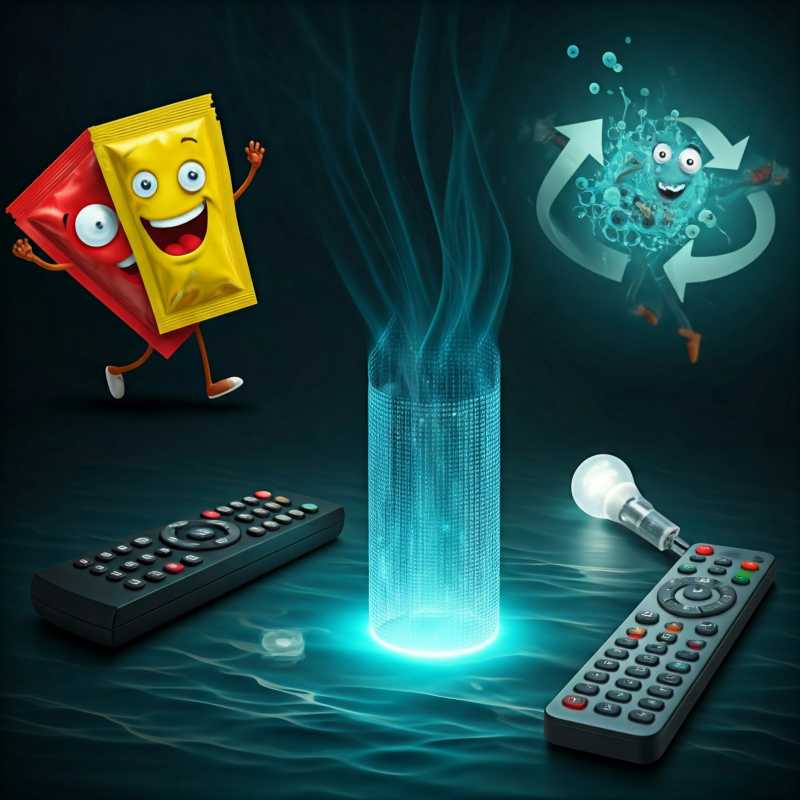How Mexican Scientists Are Brewing Batteries from Plastic Trash
Mexican scientists are developing eco-friendly batteries from recycled plastics, primarily ketchup packets. These thin, lightweight batteries use seawater as electrolyte, costing significantly less than commercial ones. Tested in various devices, they aim to power phones and even cars.

Using recycled plastics, a team of Mexican scientists led by Jorge Oliva Uc, a researcher at the UNAM Center for Applied Physics and Advanced Technology, based in Juriquilla, Querétaro, is developing batteries. The goal is to reduce the presence of plastics in the environment, since when they degrade, they produce microplastics that end up in the soil, rivers, and oceans.
Various materials of this type are single-use, such as mayonnaise, ketchup, etc., so we decided to explore how feasible it is to recover them to place carbon electrodes (electrical conductors) on them, which will be assembled to make batteries that are capable of competing with AA and AAA batteries, which are heavy - between 40 and 100 grams - and contain zinc, acids, and toxic heavy metals. In contrast, the ones we make have a maximum thickness of one millimeter, their weight is less than 10 grams, and they are less toxic, explained Oliva Uc.
Technology in general, and electronics in particular, tend to advance and become more compact. For example, there are flexible cell phones and batteries need to be flexible too. Soft drink labels or tomato sauce or mayonnaise packets, small and flexible, are the base material or mechanical support (made of polypropylene, polyethylene, PVC and polyester) on which we build the electrodes.
To choose this input, he explained, for two years different types of plastics were analyzed, such as those from bottles, yogurt containers, shampoo or detergents, until reaching the conclusion that these small ketchup packets are the ideal ones, among other reasons because they do not need an extra process to mold them and make them flexible.
The innovative batteries have other advantages: unlike the current ones that use toxic acid (lithium salts) they can use sea water as an electrolyte, so they are environmentally friendly.
Using recycled plastics considerably reduces their cost. The price of a commercial brand AA or AAA can be from 30 to 60 pesos. “Ours, without taking into account labor, has an approximate cost of five to eight pesos, and they are equally efficient for storing and generating charge.” There are several prototypes that are being evaluated for patenting.
The CFATA-UNAM scientist pointed out that the batteries made from recycled plastics were tested in remote controls for fans and toys, in addition to turning on LED lights. That is the first level of testing. Now what is wanted is to optimize them to reach 3.7 volts, the battery used by a mobile phone; and, later, achieve 12 volts to compete with car batteries.
According to the report From pollution to solution: a global assessment of marine litter and plastic pollution (2021) of the United Nations Environment Program, microplastics are a growing threat in all ecosystems, especially for the sea.
The document highlights that plastics represent 85 percent of the waste that reaches the oceans and warns that by 2040 the volumes that will flow will almost triple, with an annual amount of 23 to 37 million tons. This means approximately 50 kilograms per meter of coastline in the world.
In Mexico, according to figures from the first National Inventory of Sources of Plastic Pollution (2023), from the Ministry of Environment and Natural Resources, the annual per capita consumption of this product was estimated at 66 kilograms, and the generation of waste at 59 kilograms. The proportion of poorly managed waste with a high potential for leakage into the environment is 38 to 58 percent.
In parallel, the Oliva Uc team is working on the reuse of lithium batteries, especially those from mobile phones. Graphite and electrodes are used to obtain another type of battery that, although not as efficient for a cell phone, is useful for objects that consume less energy.
What motivates us to work on recycling their components is that electric cars are starting to sell in tens of thousands of units and compete with combustion cars. When these types of cars are eight years old, their batteries expire. “What are we going to do with all that material?” he asked.
We are moving forward to develop methodologies and reuse the parts of lithium accumulators from electric cars (donated by a company in San Luis Potosí) and thus manufacture another type of battery that can be used to power smaller objects, such as toys, television controls, etc.
The aim is also to reuse battery electrodes made from recycled plastics as floats to remove contaminants from water: dyes, herbicides or drugs, because 40 percent of wastewater treatment plants in Mexico have difficulty removing traces of these compounds. In fact, most of these places are not designed to do so because they did not exist before, he emphasized.
The electrode, being a thin plastic, can receive additional treatment to be used for these purposes, since when interacting with sunlight it eliminates contaminating compounds from the water.
We want to maximize its use in such a way that its use and reuse delays its final disposal as much as possible, and in this way also delays environmental contamination, he stressed.
In the multidisciplinary group there are 11 academics from different entities such as the Potosino Institute of Scientific and Technological Research; the Center for Research and Advanced Studies of the National Polytechnic Institute, Saltillo; the autonomous universities of Coahuila and Querétaro; the Western Institute of Technology and Higher Education; as well as undergraduate and graduate students from UNAM.




